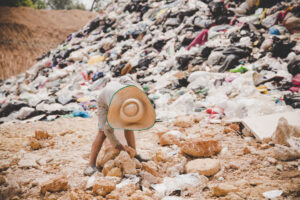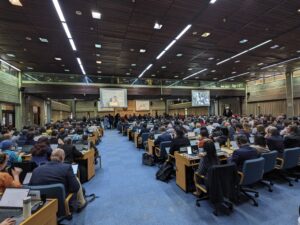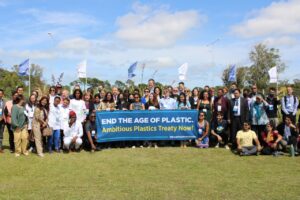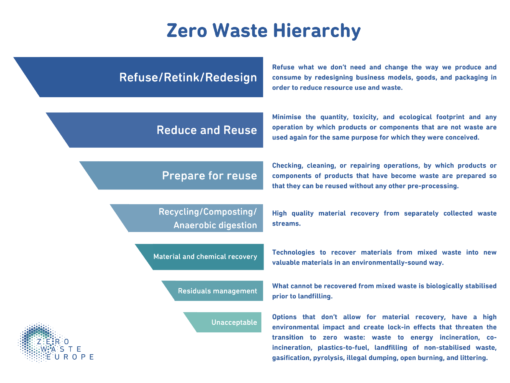
A zero waste hierarchy for Europe
When the current waste hierarchy was conceived (1), waste management was about disposing of our waste with the minimum damage to health and the environment. Despite its non-binding nature, it has proven to be a good tool to provide guidance in the transition to modern waste management.
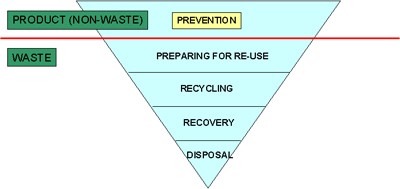
Source: Directive 2008/98/EC on waste (Waste Framework Directive)
Yet the waste hierarchy is limited and limiting because it looks at things from a solely environmental standpoint, i.e. it doesn’t take into account social, economic and logistic considerations or the need to spur a transition towards circularity.
With the new mental frame set by the Circular Economy thinking, we believe a new hierarchy is needed to change the mindset from waste management to resource management. This means that the driving force of the hierarchy should be not only the safe disposal of our waste but also to ensure that the value of our resources is preserved in the economy for the new generations.

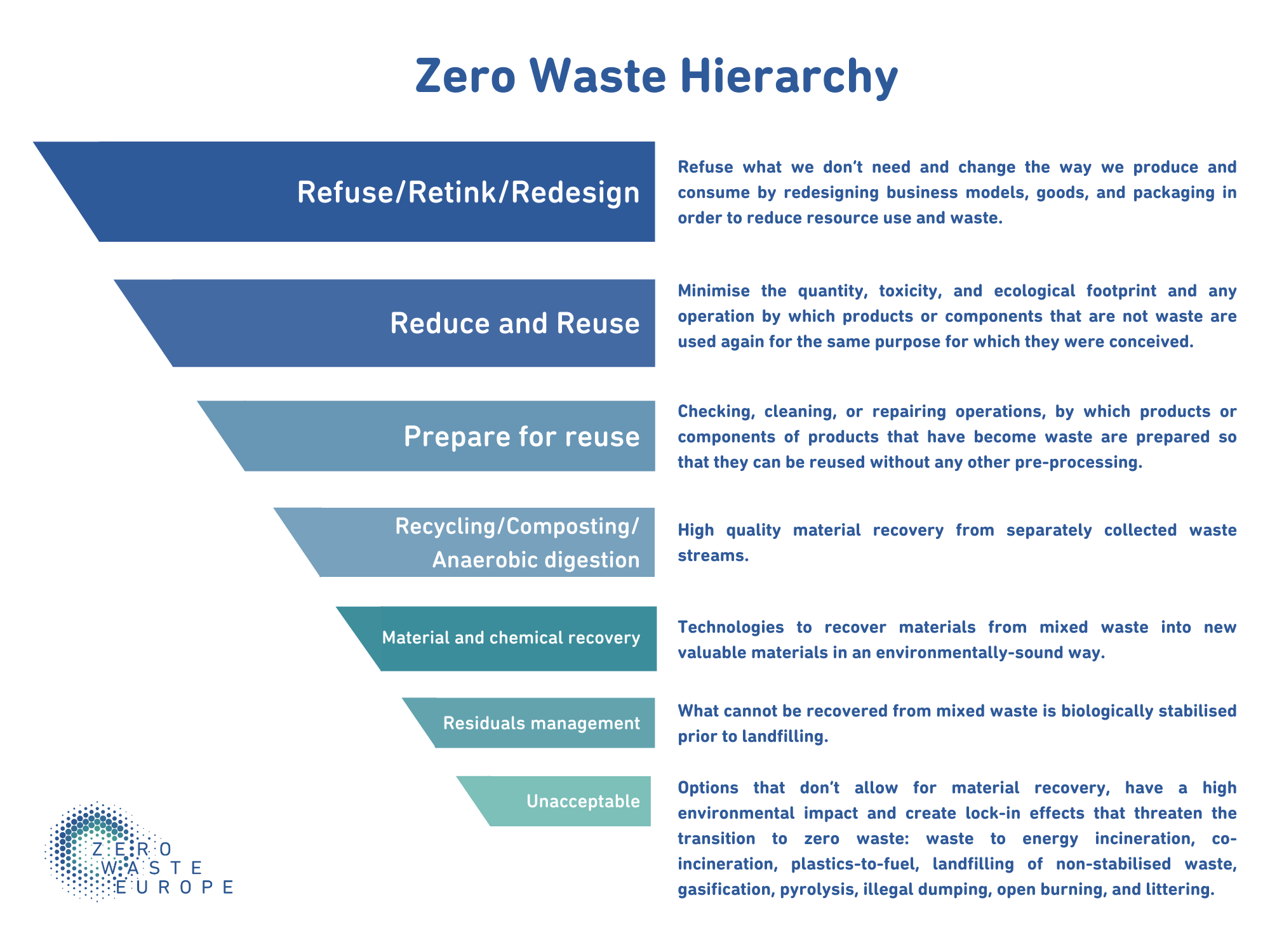 The diagram shows how the Zero Waste hierarchy differs from the EU waste hierarchy in the upper and lower levels whilst it keeps the middle levels of preparation for reuse and recycling.
The diagram shows how the Zero Waste hierarchy differs from the EU waste hierarchy in the upper and lower levels whilst it keeps the middle levels of preparation for reuse and recycling.
Talking about value preservation basically means making products and packaging stay in the economy for longer, not as waste but as materials and products. In practice this means that whilst the milestone of the current waste hierarchy is recycling, the milestone of the zero waste hierarchy we are proposing is value preservation via designing waste out of the system.
This is why in the new hierarchy we turn the most forgotten and under-invested level of the current hierarchy in the cornerstone of the Circular Economy for the coming years. Designing waste out of the system by influencing consumption habits, rethinking business models and making them waste-free by design, should be the main priority of economic and environmental EU policies and funding. This first level alone will need dedicated legislation that deals with value preservation and not with waste.
Further down the hierarchy, we propose a new approach to disposal which is consistent with the current transition happening in Europe in terms of resource management and decarbonisation of energy mix. In this sense, it replaces the energy recovery vector with cost-effectiveness, value preservation, which also liaises with better energetic efficiency, given the much lower energetic intensity of reuse and recycling relative to incineration and disposal (2) and above all flexibility.
The Zero Waste hierarchy has 7 levels, two related to products and 5 related to waste:
1. REFUSE, RETHINK, REDESIGN
The 1st level encapsulates any activity related to stopping waste from being produced. Be it by creating a system that is waste free by design or by stopping the commercialisation of single-use items that can be easily replaced with alternatives.
Examples:
Food delivery, take away food but could be also applied to e-commerce, should use reusable packaging in closed loop systems. We can see examples in Repack, ReCircle, and Freiburg Cup. For this to become the new norm we need progressive regulations.
For e-commerce reusable systems such as RePack could become more competitive if Extended Producer Responsibility (EPR) fees are eco-modulated to make reuse more cost-competitive than single-use or if regulators set ambitious targets for reuse of e-commerce packaging or for collection rates.
2. REDUCE AND REUSE
Staying in the non-waste zone, the second level of the hierarchy tackles the scaling up of the market for used items which have not become waste, remain an underutilised asset of our economies or will become waste despite not having lost their use value. The goal is to prevent them from being discarded and instead find ways for them to go back in the economy.
Examples:
In the food sector Phoenix has developed a system for supermarkets to prevent food from becoming waste and make it available for consumption.
Ereuse developed a system to not only stop ewaste from being generated and have the products and components expand its use life, but also introduce block-chain technology to trace the components for the future, measure their performance and ensure they will be appropriately recycled at the end of their life.
3. PREPARATION FOR REUSE
Moving into the waste area, the third level of the Zero Waste hierarchy reflects the second level of the EU waste hierarchy: preparation for reuse reproduces the efforts to clean, repair and refurbish items that have become waste in order for them to become products again.
Example:
The refurbishment of white appliances such as fridges to make them suitable to be used again.
4. RECYCLING, COMPOSTING, ANAEROBIC DIGESTION
The 4th level of the hierarchy deals with what, in an ideal scenario, should be the last option to retain materials in sustainable resource management, namely to turn the separately collected waste into high quality secondary raw materials. This level mirrors the 3rd level of the current EU waste hierarchy.
Example:
Turning separately collected paper or cardboard into cellulose for new products or packaging. Turning source separated high quality organics into soil improvers by means of composting and/or anaerobic digestion (3) so as to restore fertility of soils.
5. MATERIAL AND CHEMICAL RECOVERY
As explained, the Zero Waste hierarchy differs from and supplements the EU’s one in the configuration of its lowest levels. The EU waste hierarchy places energy recovery as the next step after recycling, whilst the Zero Waste hierarchy prioritises the extraction of valuable materials from the mixed waste and the discards from sorting processes. This is better aligned with the vision of Circular Economy, which is basically about retaining materials and resources within the loop, whereas thermal treatment shows as a “leakage of resources”. Material Recovery and Biological Treatment operations on mixed waste in systems with high separate collection rates –as it is demanded by the new EU waste legislation- provide a cost-effective way to preserve the value of resources whilst minimising disposal. The new technologies related to chemical recycling also fit in this level as long as they deal with the discards of sorting processes -and not with separately collected streams- and they transform used polymers into new ones.
6. RESIDUALS MANAGEMENT
The current EU waste legislation obliges to source separate and separately collect the waste streams, allowing for most of the biologically active waste to be diverted from the residual waste. By means of prior biological stabilisation, the waste can be safely landfilled, in full compliance with the Landfill Directive and related obligation on pre-treatment. Such systems may be designed to work on increasing amounts of source separated organics, and decreasing amounts of residual waste. The transition that Europe is going to see in the coming years, very much depending on the success in advancing towards waste-free systems by design –see levels 1 and 2-, should see the amounts of residual waste dwindle and will require flexibility to adapt to the new scenario.
7. UNACCEPTABLE
The new hierarchy qualify as unacceptable the options creating lock-in effects that obstruct the transition, destroy resources and/or are environmentally unacceptable. Landfilling of non-stabilised waste, littering and any sort of combustion or co-combustion of mixed waste, with or without oxygen, are options that should become part of the past because they contradict the EU decarbonisation agenda and absorb investments that should be directed to the highest levels of the hierarchy.
Conclusions
The EU waste hierarchy is not perfect but it is serving Europe well to minimise the environmental impact of our waste management activities. However, it is unfit to achieve the ambitious circularity and sustainability goals that we are setting for ourselves.
We need new tools for the new times, and the Zero Waste hierarchy we propose is a tool that sets the right priorities to achieve Europe’s Circular Economy goals.
NOTE: The Zero Waste Hierarchy has been developed in cooperation with the Zero Waste International Alliance of which Zero Waste Europe is a member.
